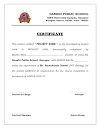BIOLOGY (Code No. 044)
COURSE STRUCTURE
CLASS XI (2021-22) (THEORY)
Unit-I Diversity of Living Organisms
Chapter-1: The Living World
What is living? Biodiversity; Need for classification; taxonomy and systematics; concept of species and taxonomical hierarchy; binomial nomenclature; tools for study of taxonomy-museums, zoological parks, herbaria, botanical gardens, keys for identification.
Chapter-2: Biological Classification
Five kingdom classification; Salient features and classification of Monera, Protista and Fungi into major groups; Lichens, Viruses and Viroids.
Chapter-3: Plant Kingdom
Salient features and classification of plants into major groups - Algae, Bryophyta, Pteridophyta, Gymnospermae and Angiospermae (salient and distinguishing features and a few examples of each category): Angiosperms - classification up to class, characteristic features and examples.
Plant life cycles and alternation of generations
Chapter-4: Animal Kingdom
Basis of Classification; Salient features and classification of animals, non-chordates up to phyla level and chordates up to class level (salient features and distinguishing features of a few examples of each category).
(No live animals or specimen should be displayed in school.)
Unit-II Structural Organization in Plants and Animals
Chapter-5: Morphology of Flowering Plants
Morphology and modifications: Morphology of different parts of flowering plants: root, stem, leaf, inflorescence, flower, fruit and seed. Description of families: Fabaceae, Solanaceae and Liliaceae (to be dealt along with the relevant experiments of the Practical Syllabus).
Chapter-6: Anatomy of Flowering Plants
Anatomy and functions of different tissues and tissue systems in dicots and monocots. Secondary growth.
Chapter-7: Structural Organisation in Animals
Animal tissues; Morphology, Anatomy and functions of different systems (digestive, circulatory, respiratory, nervous and reproductive) of an insect-cockroach (a brief account only).
Unit-III Cell: Structure and Functions
Chapter-8: Cell-The Unit of Life
Cell theory and cell as the basic unit of life, structure of prokaryotic and eukaryotic cells; Plant cell and animal cell; cell envelope; cell membrane, cell wall; cell organelles - structure and function; endomembrane system- endoplasmic reticulum, ribosomes, golgi bodies, lysosomes, vacuoles; mitochondria, plastids, microbodies; cytoskeleton, cilia, flagella, centrioles (ultrastructure and function); nucleus.
Chapter-9: Biomolecules
Chemical constituents of living cells: biomolecules, structure and function of proteins, carbohydrates, lipids, nucleic acids; concept of metabolism; Enzymes - properties, enzyme action, factors, classification, Co-factors.
Chapter-10: Cell Cycle and Cell Division
Cell cycle, mitosis, meiosis and their significance
Unit-IV Plant Physiology
Chapter-11: Transport in Plants
Movement of water, gases and nutrients; cell to cell transport - diffusion, facilitated diffusion, active transport; plant-water relations, imbibition, water potential, osmosis, plasmolysis; long distance transport of water - Absorption, apoplast, symplast, transpiration pull, root pressure and
guttation; transpiration, opening and closing of stomata; Uptake and translocation of mineral nutrients - Transport of food, phloem transport, mass flow hypothesis.
Chapter-12: Mineral Nutrition
Elementary idea of hydroponics as a method to study mineral nutrition; essential minerals, macro- and micronutrients and their role; deficiency symptoms; mineral toxicity; nitrogen metabolism, nitrogen cycle, biological nitrogen fixation.
Chapter-13: Photosynthesis in Higher Plants
Photosynthesis as a means of autotrophic nutrition; early experiments, site of photosynthesis, pigments involved in photosynthesis (elementary idea); photochemical and biosynthetic phases of photosynthesis; cyclic and non-cyclic photophosphorylation; chemiosmotic hypothesis; photorespiration; C3 and C4 pathways; factors affecting photosynthesis.
Chapter-14: Cellular Respiration
Exchange of gases; do plants breathe; cellular respiration - glycolysis, fermentation (anaerobic), TCA cycle and electron transport system (aerobic); energy relations - number of ATP molecules generated; amphibolic pathways; respiratory quotient.
Chapter-15: Plant - Growth and Development
Seed germination; characteristics, measurements and phases of plant growth, growth rate; conditions for growth; differentiation, dedifferentiation and redifferentiation; sequence of developmental processes in a plant cell; growth regulators - auxin, gibberellin, cytokinin, ethylene, ABA; seed dormancy; vernalisation; photoperiodism.
Unit-V Human Physiology
Chapter-16: Digestion and Absorption
Alimentary canal and digestive glands, role of digestive enzymes and gastrointestinal hormones; Peristalsis, digestion, absorption and assimilation of proteins, carbohydrates and fats; egestion; nutritional and digestive disorders - indigestion, constipation, vomiting, jaundice, diarrhoea.
Chapter-17: Breathing and Exchange of Gases
Introduction to respiratory organs in animals; Respiratory system in humans; mechanism of breathing and its regulation in humans - exchange of gases, transport of gases and regulation of respiration, respiratory volumes; disorders related to respiration - astma, emphysema, occupational respiratory disorders.
Chapter-18: Body Fluids and Circulation
Composition of blood, blood groups, coagulation of blood; composition of lymph and its function; circulatory pathways; human circulatory system - Structure of human heart and blood vessels; cardiac cycle, cardiac output, ECG; double circulation; regulation of cardiac activity; disorders of circulatory system - hypertension, coronary artery disease, angina pectoris, heart failure.
Chapter-19: Excretory Products and their Elimination
Modes of excretion - ammonotelism, ureotelism, uricotelism; human excretory system – structure and function; urine formation, osmoregulation; regulation of kidney function - renin - angiotensin, atrial natriuretic factor, ADH, diabetes insipidus; micturition; role of other organs in excretion; disorders - uremia, renal failure, renal calculi, nephritis; dialysis and artificial kidney, kidney transplant.
Chapter-20: Locomotion and Movement
Types of movement – amoeboid, ciliary, flagellar, muscular; types of muscles; skeletal muscle, contractile proteins and muscle contraction; skeletal system and its functions; joints; disorders of muscular and skeletal systems - myasthenia gravis, tetany, muscular dystrophy, arthritis, osteoporosis, gout.
Chapter-21: Neural Control and Coordination
Neuron and nerves; Nervous system in humans - central nervous system and peripheral nervous system; generation, conduction and transmission of nerve impulse; reflex action; sensory perception; sense organs; elementary structure and functions of eye and ear.
Chapter-22: Chemical Coordination and Integration
Endocrine glands and hormones; human endocrine system - hypothalamus, pituitary, pineal, thyroid, parathyroid, thymus, adrenal, pancreas, gonads; hormones of heart, kidney and gastrointestinal tract; mechanism of hormone action (elementary idea); role of hormones as messengers and regulators, hypo - and hyperactivity and related disorders; dwarfism, acromegaly, cretinism, goiter, exophthalmic goiter, diabetes, Addison's disease.
Note: Diseases related to all the human physiological systems to be taught in brief.






1 Comments
Thanks
ReplyDelete